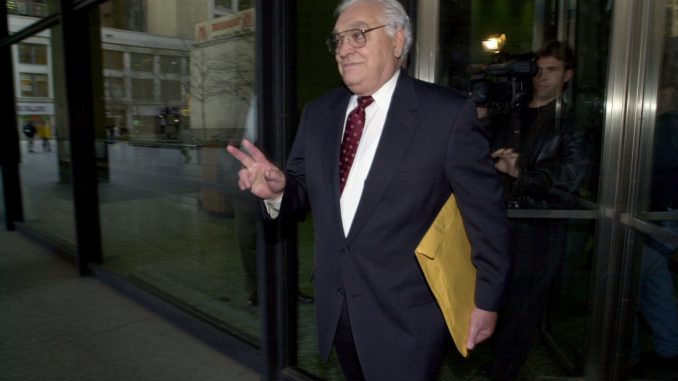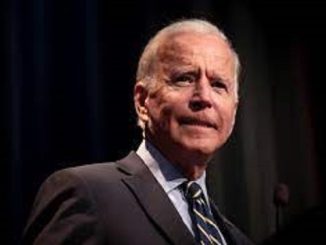
William Hanhardt, a former high-ranking Chicago Police official who spent years in prison for running a mob-connected jewel-theft ring, has died at age 88.
Hanhardt, a former deputy police superintendent and chief of detectives, died Friday at Highland Park Hospital from complications from chronic obstructive pulmonary disease, according to his family. He had been living in Deerfield and previously lived in the Far Northwest Side’s Edison Park neighborhood, where the funeral is tentatively scheduled for Tuesday.
Hanhardt has been described as one of the most crooked cops in Chicago history, with federal prosecutors saying he ran a mob-tied, highly sophisticated theft ring that stole tens of millions of dollars worth of jewelry from salesmen across the country. He worked for the Chicago Police for 33 years and is the highest-ranking former Chicago Police officer ever to be convicted of a crime. While publicly he was viewed as a cop’s cop during his time on the force, federal prosecutors have said Hanhardt was long one of the Outfit’s men at the department.
In the 1960s, Hanhardt allegedly took $1,000 in bribes a month and a new car every two years from Outfit boss Angelo Volpe, according to testimony in the historic Family Secrets mob case.
“His greed and loyalty was to the mob and to his mob-associated jewelry theft crew, which were more important to him than his family, the Chicago Police Department or the citizens that he was sworn to protect,” then-Assistant U.S. Attorney John Scully said at Hanhardt’s sentencing hearing in May 2002. After an appeal, Hanhardt would be sentenced to 12 years behind bars and was released from prison in 2011.
In an unusual twist, given his mob ties, Hanhardt played a mob killer in a brief appearance in Michael Mann’s 1980s television show “Crime Story.”
On Friday, Hanhardt’s family said his life shouldn’t be defined by his court case, with one of his seven children, Sara, describing him as a “wonderful man” who lived “his whole life just helping other people . . . heaven gained an angel this morning.”
Hanhardt had a birthday recently and “everybody got to spend time with him, it was a beautiful party,” she said.
She said Christmas was his favorite holiday, and he loved getting away to Minocqua, Wisc.
“He vacationed in Minocqua for 60 years,” said a son-in-law, Joel Levin.
Hanhardt and his widow, Angeline, had been a couple for 72 years in total, according to family. They had 18 grandchildren and 19 great-grandchildren, according to Levin, who said Hanhardt “had a presence about him . . . he was larger than life.”
In prison, Hanhardt dealt with a series of health problems, including cancer and heart disease, but remained focused on getting back home to his family, said Jeff Steinback, one of his attorneys.
Few people will note the positive things Hanhardt did, Steinback said. “They’re all overshadowed by the case. But they still count in my mind. And they start with the quiet dignity and courage he demonstrated consistently, the love he had for his family, and the stoicism he so often displayed when it came to his own difficulties. There was a tremendous physical toughness about him, but an even more powerful mental toughness.”
Thomas P. Sullivan, who served as U.S. attorney in Chicago from 1977 to 1981, said he was a young defense attorney when he first met Hanhardt in the early 1960s, then got to know him more when Sullivan represented police officers charged with killing Black Panthers Fred Hampton and Mark Clark in 1969.
“He was a very commanding presence — a big man,” Sullivan recalled of Hanhardt. “He was a fine police officer. That’s my understanding and my belief.”
Sullivan later worked as one of Hanhardt’s lawyers during his criminal case.
“I don’t have anything negative to say about Bill Hanhardt,” Sullivan said. “He was a friend of mine, and I respected him.”
Hanhardt became a police officer in 1953, and his years on the street sometimes made headlines, at times along with his fellow officer, John Hinchy. In 1962, while staking out a North Side home, Hanhardt encountered three robbers with a submachine gun and ended up in a shootout in which two of the suspects were killed. In 1973 he helped find the body of a slain Hillside police officer. In 1976 he caught the killer of Chicago Police Officer Thomas Loftus, who was shot in the Shakespeare District where Hanhardt was the commander. Several years later, while deputy superintendent, he was demoted by acting Supt. Joseph DiLeonardi, who suspected Hanhardt of having ties to the 1st Ward, which was then controlled by the mob. Hanhardt was later promoted to chief of detectives by Supt. Richard Brzeczek. Hanhardt was skilled at currying favor, whether it was acting as an invaluable source for reporters or tipping FBI agents to key details about crimes.
Hanhardt retired from the force in 1986 not long after testifying at the trial of mobster Anthony Spilotro – then the Chicago mob’s main man in Las Vegas – and discrediting a key witness. Even after retiring from the CPD, he continued to wield significant influence there, given how many careers he had helped make.
The feds began looking into Hanhardt’s jewel-theft ring in the mid-1990s. Those agents, though, faced some initial institutional resistance within the FBI when they first began proposing an investigation. Hanhardt’s crew – which started its work while Hanhardt was still on the force, and included mob hit man Paul Schiro, authorities said – stalked jewelry salesmen around the country, analyzing their travel patterns, making duplicate keys of their cars and enlisting private information from police databases, courtesy of Hanhardt’s old colleagues on the force.
A jewelry industry official said at the time of Hanhardt’s guilty plea, “I’ve not seen anything as detailed and as lengthy as the dossiers they put together on the traveling salesmen,” calling the gang’s work “unprecedented.”
Hanhardt’s criminal conviction didn’t end his taxpayer income. He continued to collect his police pension because he started as a cop two years before a felony forfeiture rule was enacted. At last count, he was drawing more than $70,000 a year.
By Robert Herguth and Mick Dumke
Source chicago.suntimes.com





Be the first to comment